This post may contain affiliate links. Please read our
disclosure policy
for more information.
We’ve all been there – standing in front of the microwave oven with leftovers in one hand and a Ziploc bag in the other, wondering, “Is this okay to do?” It’s a modern-day kitchen quandary: Can you actually put Ziploc bags in the microwave without starting a mini science experiment or, worse, compromising your health?
In the age of convenience, we’re often looking for quick and easy solutions for our meals, especially when it comes to reheating or defrosting. But with this convenience comes a plethora of questions, particularly about microwave safety and the use of plastic containers.
Well, you don’t have to wonder anymore! Today, we’re going to sift through the facts, debunk myths, and provide you with clear, straightforward guidance on the safety and best practices of microwaving Ziploc bags. Whether you’re a busy parent, a meal-prep pro, or just someone who loves their leftovers, here’s the info you need to nuke with confidence.
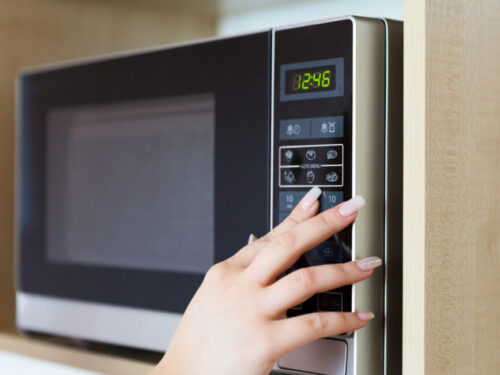
Understanding Microwave Safety
Let’s take a moment to heat up our knowledge about microwaves and the safety of using plastic in them. When it comes to zapping our food to the perfect temperature, there’s a bit of science and caution involved.
How Do Microwaves Work?
- The Science Behind Microwaves: Microwaves heat food by causing water molecules in it to vibrate at high speeds, creating heat. It’s a quick, efficient way to heat food, but it also means we need to be careful about what we put in there.
The Concerns of Heating Plastic
- Chemical Leaching: The main concern of microwaving plastic is the potential for harmful chemicals to leach into food. This is particularly an issue with certain plastics that aren’t designed to withstand high heat.
- Melting & Warping: At high temperatures, some plastics can melt or warp. This will not only ruin your container but can also make your food unsafe to eat.
- Uneven Heating: Microwaves can heat food unevenly, leading to hot spots and cold spots. That can pose a food safety risk, especially with meats and other perishable items. Stirring food midway through heating can help alleviate this problem.
- Pressure: Microwaving sealed and unvented containers can lead to pressure build-up. This might cause your bag or container to burst open, potentially causing a mess or even burns.
The Importance of Using Microwave-Safe Materials
- Food Safety Standards: Using materials that meet the safety requirements of the U.S. Food and Drug Administration (FDA) is crucial. These materials are tested to ensure they can handle microwave temperatures without melting or releasing harmful substances.
- Alternatives to Plastic: Whenever possible, use microwave-safe containers like glass or ceramic. They’re a foolproof way to avoid any issues related to microwaving plastics.
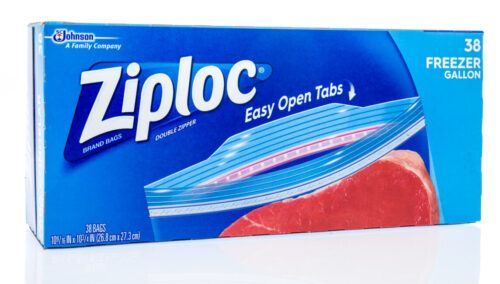
All About Ziploc Bags
Plastic baggies seem to be a staple of every kitchen. Understanding what they’re made of and their uses is key, especially when we’re talking about popping them into the microwave.
The Ziploc Bag Basics
- Material: Ziploc brand bags are typically made from low-density polyethylene plastic (LDPE). This material is known for its durability and flexibility.
- Uses: From storing leftovers to keeping your veggies fresh, Ziploc bags have become a go-to for food storage. They’re great for organizing ingredients, marinating meats, and even come in handy for non-food uses.
Ziploc Bags vs. Other Plastic Bags
- Not All Bags are Created Equal: While we often use the term ‘baggie’ generically, there’s a world of difference between your average plastic bag and Ziploc products. Regular plastic bags, like the ones you get at grocery stores or come with your bread, aren’t designed for high heat or microwave use.
- Safety First: Ziploc bags are generally designed to withstand higher temperatures. They’re a safer bet than water bottles or food containers that weren’t made for the microwave.
- Check the Label: Many sealable bags come with label directions that indicate if they’re suitable for microwave use. Following these directions is the best way to ensure you’re using the product safely.
Concerns Around Microwaving Plastic
- High Temperatures and Health Risks: When plastic is exposed to high heat, like in a microwave, there’s a concern about harmful chemicals like Bisphenol A (BPA) leaching into food. The good news? Most Ziploc products are BPA-free and are made to meet the safety requirements of the U.S. Food and Drug Administration.
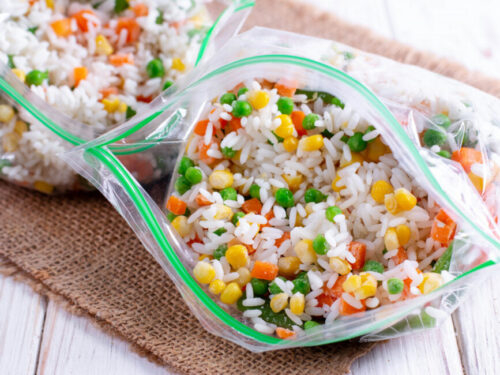
Can I Microwave Ziploc Bags?
Alright, let’s tackle the burning question: Can you microwave Ziploc bags? The short answer is yes, but there’s a bit more to it. Let’s dive into the best practices for microwaving food in Ziploc bags, so next time you’re in a pinch, you’ll know just what to do.
Temperature Thresholds of Ziploc Bags
- Softening Point: Ziploc brand bags typically have a softening point of about 195 degrees Fahrenheit. This means that when the temperature inside the microwave reaches this point, the plastic may begin to soften and lose its shape.
- Microwaving Temperature: To play it safe, it’s recommended to keep the temperature around 170 degrees Fahrenheit or below when microwaving with Ziploc bags. Using a low power setting can help manage this and prevent the bag from getting too hot and potentially melting.
Best Practices for Microwaving Ziploc Bags
- Use as a Container, Not for Cooking: Think of the Ziploc bag as a container for reheating, rather than a cooking vessel. It’s not ideal for cooking food, but rather for warming it up gently.
- Use a Microwave Safe Dish: Place Ziploc bags on a microwave-safe dish when heating. Since Ziploc bags aren’t designed to stand upright on their own, they are prone to tipping over during the microwaving process. Any unnoticed small holes or tears in the bag could cause leaks, not only creating a mess but potentially damaging your microwave.
- No Vacuum Sealing: Don’t use a vacuum sealer on the bag before microwaving. These bags are not designed for high vacuum pressure, and sealing them could lead to a burst in the microwave.
- Venting is Crucial: Always leave a small corner of the bag open when microwaving. This allows steam to escape, preventing pressure build-up and the risk of the bag exploding.
- Avoid High Temperatures: Microwaving on a low power setting is a great way to prevent the bag from getting too hot and potentially melting. Remember, most Ziploc bags aren’t designed to withstand boiling water.
- Don’t Overheat: Keep an eye on the time. Overheating can cause the plastic to melt, which is a no-go. We recommend heating in 30 second intervals, and discarding after use. (Don’t reuse the same bag to reheat another meal.)
- Safe Alternatives: If you’re unsure, transfer the food to a microwave-safe container. It’s a foolproof way to ensure your food heats evenly and safely.
The Exception to Boiling: Ziploc Endurables®
- Designed for Extremes: Ziploc Endurables® Large Silicone Pouches are an exception to the typical Ziploc temperature limits. These pouches are boilable and can handle a journey directly from the freezer, to the oven, to the table.
- Material and Durability: Made with durable and reusable platinum silicone, these half-gallon pouches are designed to withstand extreme temperatures, up to 425°F. This makes them a great option for a variety of cooking and reheating needs.
After Microwaving
- Handle with Care: After microwaving, handle the bag carefully. Contents can be hot, and steam can escape quickly when you open it fully.
- Discard if Damaged: If you notice any melting or deformation of the bag, it’s best to discard it and avoid using it again.
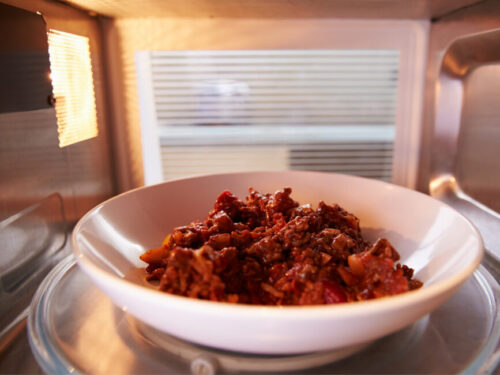
Here are Some FAQs About Microwaving Other Types of Materials
Q: What types of containers are generally safe to use in the microwave?
A: Microwave-safe containers typically include those made of glass, ceramic, and certain plastics designed to withstand microwave temperatures. Always look for a label or symbol indicating that the container is microwave-safe. Avoid using containers made of metals, as they can cause sparks and damage your microwave.
Q: Can I use takeout containers or plastic tubs in the microwave?
A: It depends. Some takeout containers are microwave-safe, but others are not. Check for a microwave-safe label. As for plastic tubs (like yogurt or margarine tubs), they’re often not suitable for microwave use as they can melt or warp at high temperatures, potentially leaching chemicals into your food.
Q: How can I tell if a container is microwave-safe?
A: Look for a microwave-safe symbol or label on the bottom of the container. This symbol usually looks like a microwave, waves, or a PP symbol, indicating it’s made of polypropylene. If you’re unsure or if the container has no label, it’s safer to transfer the food to a known microwave-safe dish.
Q: Are there any health risks associated with microwaving food in plastic containers?
A: The main concern is the potential for harmful chemicals like BPA or phthalates to leach into food from certain plastics when heated. Using BPA-free and microwave-safe labeled plastics reduces this risk.
Q: Can aluminum foil be used in the microwave?
A: Never use aluminum foil in the microwave, as it can cause sparks and fire hazards.
Q: Is it safe to reheat food in styrofoam containers in the microwave?
A: It’s best to avoid microwaving styrofoam containers. They can melt or break down at high temperatures, potentially releasing harmful chemicals. Transfer food to a microwave-safe container instead.
Q: Can I microwave a container if it’s marked “dishwasher safe”?
A: Not necessarily. “Dishwasher safe” doesn’t mean microwave-safe. These are different standards, as dishwashers and microwaves subject containers to different types of stress and temperatures.
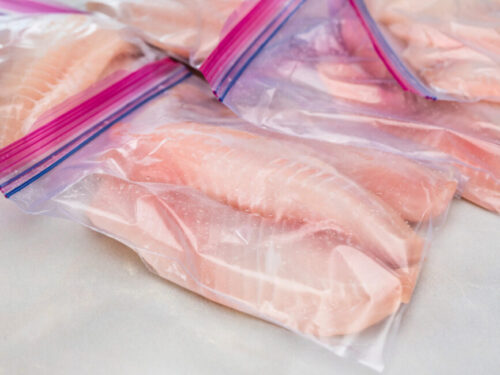
Now You Know!
We hope you enjoyed this complete and demystified guide to microwaving with Ziploc bags, and that we made your kitchen life just a little bit easier.
Microwaving with Ziploc bags can be a real game-changer for those busy days or quick meal preps, as long as it’s done safely and smartly. So go ahead, give it a try with confidence, and enjoy the convenience it brings to your kitchen routine. And hey, if you’ve got any microwaving hacks or stories to share, we’re all ears! Drop them in the comments below – let’s keep the conversation cooking.
This post may contain affiliate links. Please read our
disclosure policy
for more information.
This post may contain affiliate links. Please read our
disclosure policy
for more information.
We’ve all been there – standing in front of the microwave oven with leftovers in one hand and a Ziploc bag in the other, wondering, “Is this okay to do?” It’s a modern-day kitchen quandary: Can you actually put Ziploc bags in the microwave without starting a mini science experiment or, worse, compromising your health?
In the age of convenience, we’re often looking for quick and easy solutions for our meals, especially when it comes to reheating or defrosting. But with this convenience comes a plethora of questions, particularly about microwave safety and the use of plastic containers.
Well, you don’t have to wonder anymore! Today, we’re going to sift through the facts, debunk myths, and provide you with clear, straightforward guidance on the safety and best practices of microwaving Ziploc bags. Whether you’re a busy parent, a meal-prep pro, or just someone who loves their leftovers, here’s the info you need to nuke with confidence.

Understanding Microwave Safety
Let’s take a moment to heat up our knowledge about microwaves and the safety of using plastic in them. When it comes to zapping our food to the perfect temperature, there’s a bit of science and caution involved.
How Do Microwaves Work?
- The Science Behind Microwaves: Microwaves heat food by causing water molecules in it to vibrate at high speeds, creating heat. It’s a quick, efficient way to heat food, but it also means we need to be careful about what we put in there.
The Concerns of Heating Plastic
- Chemical Leaching: The main concern of microwaving plastic is the potential for harmful chemicals to leach into food. This is particularly an issue with certain plastics that aren’t designed to withstand high heat.
- Melting & Warping: At high temperatures, some plastics can melt or warp. This will not only ruin your container but can also make your food unsafe to eat.
- Uneven Heating: Microwaves can heat food unevenly, leading to hot spots and cold spots. That can pose a food safety risk, especially with meats and other perishable items. Stirring food midway through heating can help alleviate this problem.
- Pressure: Microwaving sealed and unvented containers can lead to pressure build-up. This might cause your bag or container to burst open, potentially causing a mess or even burns.
The Importance of Using Microwave-Safe Materials
- Food Safety Standards: Using materials that meet the safety requirements of the U.S. Food and Drug Administration (FDA) is crucial. These materials are tested to ensure they can handle microwave temperatures without melting or releasing harmful substances.
- Alternatives to Plastic: Whenever possible, use microwave-safe containers like glass or ceramic. They’re a foolproof way to avoid any issues related to microwaving plastics.

All About Ziploc Bags
Plastic baggies seem to be a staple of every kitchen. Understanding what they’re made of and their uses is key, especially when we’re talking about popping them into the microwave.
The Ziploc Bag Basics
- Material: Ziploc brand bags are typically made from low-density polyethylene plastic (LDPE). This material is known for its durability and flexibility.
- Uses: From storing leftovers to keeping your veggies fresh, Ziploc bags have become a go-to for food storage. They’re great for organizing ingredients, marinating meats, and even come in handy for non-food uses.
Ziploc Bags vs. Other Plastic Bags
- Not All Bags are Created Equal: While we often use the term ‘baggie’ generically, there’s a world of difference between your average plastic bag and Ziploc products. Regular plastic bags, like the ones you get at grocery stores or come with your bread, aren’t designed for high heat or microwave use.
- Safety First: Ziploc bags are generally designed to withstand higher temperatures. They’re a safer bet than water bottles or food containers that weren’t made for the microwave.
- Check the Label: Many sealable bags come with label directions that indicate if they’re suitable for microwave use. Following these directions is the best way to ensure you’re using the product safely.
Concerns Around Microwaving Plastic
- High Temperatures and Health Risks: When plastic is exposed to high heat, like in a microwave, there’s a concern about harmful chemicals like Bisphenol A (BPA) leaching into food. The good news? Most Ziploc products are BPA-free and are made to meet the safety requirements of the U.S. Food and Drug Administration.

Can I Microwave Ziploc Bags?
Alright, let’s tackle the burning question: Can you microwave Ziploc bags? The short answer is yes, but there’s a bit more to it. Let’s dive into the best practices for microwaving food in Ziploc bags, so next time you’re in a pinch, you’ll know just what to do.
Temperature Thresholds of Ziploc Bags
- Softening Point: Ziploc brand bags typically have a softening point of about 195 degrees Fahrenheit. This means that when the temperature inside the microwave reaches this point, the plastic may begin to soften and lose its shape.
- Microwaving Temperature: To play it safe, it’s recommended to keep the temperature around 170 degrees Fahrenheit or below when microwaving with Ziploc bags. Using a low power setting can help manage this and prevent the bag from getting too hot and potentially melting.
Best Practices for Microwaving Ziploc Bags
- Use as a Container, Not for Cooking: Think of the Ziploc bag as a container for reheating, rather than a cooking vessel. It’s not ideal for cooking food, but rather for warming it up gently.
- Use a Microwave Safe Dish: Place Ziploc bags on a microwave-safe dish when heating. Since Ziploc bags aren’t designed to stand upright on their own, they are prone to tipping over during the microwaving process. Any unnoticed small holes or tears in the bag could cause leaks, not only creating a mess but potentially damaging your microwave.
- No Vacuum Sealing: Don’t use a vacuum sealer on the bag before microwaving. These bags are not designed for high vacuum pressure, and sealing them could lead to a burst in the microwave.
- Venting is Crucial: Always leave a small corner of the bag open when microwaving. This allows steam to escape, preventing pressure build-up and the risk of the bag exploding.
- Avoid High Temperatures: Microwaving on a low power setting is a great way to prevent the bag from getting too hot and potentially melting. Remember, most Ziploc bags aren’t designed to withstand boiling water.
- Don’t Overheat: Keep an eye on the time. Overheating can cause the plastic to melt, which is a no-go. We recommend heating in 30 second intervals, and discarding after use. (Don’t reuse the same bag to reheat another meal.)
- Safe Alternatives: If you’re unsure, transfer the food to a microwave-safe container. It’s a foolproof way to ensure your food heats evenly and safely.
The Exception to Boiling: Ziploc Endurables®
- Designed for Extremes: Ziploc Endurables® Large Silicone Pouches are an exception to the typical Ziploc temperature limits. These pouches are boilable and can handle a journey directly from the freezer, to the oven, to the table.
- Material and Durability: Made with durable and reusable platinum silicone, these half-gallon pouches are designed to withstand extreme temperatures, up to 425°F. This makes them a great option for a variety of cooking and reheating needs.
After Microwaving
- Handle with Care: After microwaving, handle the bag carefully. Contents can be hot, and steam can escape quickly when you open it fully.
- Discard if Damaged: If you notice any melting or deformation of the bag, it’s best to discard it and avoid using it again.

Here are Some FAQs About Microwaving Other Types of Materials
Q: What types of containers are generally safe to use in the microwave?
A: Microwave-safe containers typically include those made of glass, ceramic, and certain plastics designed to withstand microwave temperatures. Always look for a label or symbol indicating that the container is microwave-safe. Avoid using containers made of metals, as they can cause sparks and damage your microwave.
Q: Can I use takeout containers or plastic tubs in the microwave?
A: It depends. Some takeout containers are microwave-safe, but others are not. Check for a microwave-safe label. As for plastic tubs (like yogurt or margarine tubs), they’re often not suitable for microwave use as they can melt or warp at high temperatures, potentially leaching chemicals into your food.
Q: How can I tell if a container is microwave-safe?
A: Look for a microwave-safe symbol or label on the bottom of the container. This symbol usually looks like a microwave, waves, or a PP symbol, indicating it’s made of polypropylene. If you’re unsure or if the container has no label, it’s safer to transfer the food to a known microwave-safe dish.
Q: Are there any health risks associated with microwaving food in plastic containers?
A: The main concern is the potential for harmful chemicals like BPA or phthalates to leach into food from certain plastics when heated. Using BPA-free and microwave-safe labeled plastics reduces this risk.
Q: Can aluminum foil be used in the microwave?
A: Never use aluminum foil in the microwave, as it can cause sparks and fire hazards.
Q: Is it safe to reheat food in styrofoam containers in the microwave?
A: It’s best to avoid microwaving styrofoam containers. They can melt or break down at high temperatures, potentially releasing harmful chemicals. Transfer food to a microwave-safe container instead.
Q: Can I microwave a container if it’s marked “dishwasher safe”?
A: Not necessarily. “Dishwasher safe” doesn’t mean microwave-safe. These are different standards, as dishwashers and microwaves subject containers to different types of stress and temperatures.

Now You Know!
We hope you enjoyed this complete and demystified guide to microwaving with Ziploc bags, and that we made your kitchen life just a little bit easier.
Microwaving with Ziploc bags can be a real game-changer for those busy days or quick meal preps, as long as it’s done safely and smartly. So go ahead, give it a try with confidence, and enjoy the convenience it brings to your kitchen routine. And hey, if you’ve got any microwaving hacks or stories to share, we’re all ears! Drop them in the comments below – let’s keep the conversation cooking.
This post may contain affiliate links. Please read our
disclosure policy
for more information.











Great tips! I had no idea that some Ziploc bags are microwave-safe. This will definitely make reheating leftovers easier for me. Thanks for the clear guidance!
Great post! I had no idea that some Ziploc bags are microwave-safe. This will definitely make meal prep easier for me. Thanks for sharing the tips and safety precautions!
Great post! I never knew about the safety concerns with microwaving Ziploc bags. Thanks for the tips on which ones are safe to use! I’ll definitely be more careful next time I heat something up.
Great post! I’ve always been hesitant about microwaving Ziploc bags, so your tips are super helpful. Thanks for clarifying which ones are safe to use!
Great post! I always wondered if it was safe to microwave Ziploc bags. Thanks for the helpful tips and clarification on which bags can handle the heat! I’ll definitely be more careful next time I use them.
Thank you for this practical article